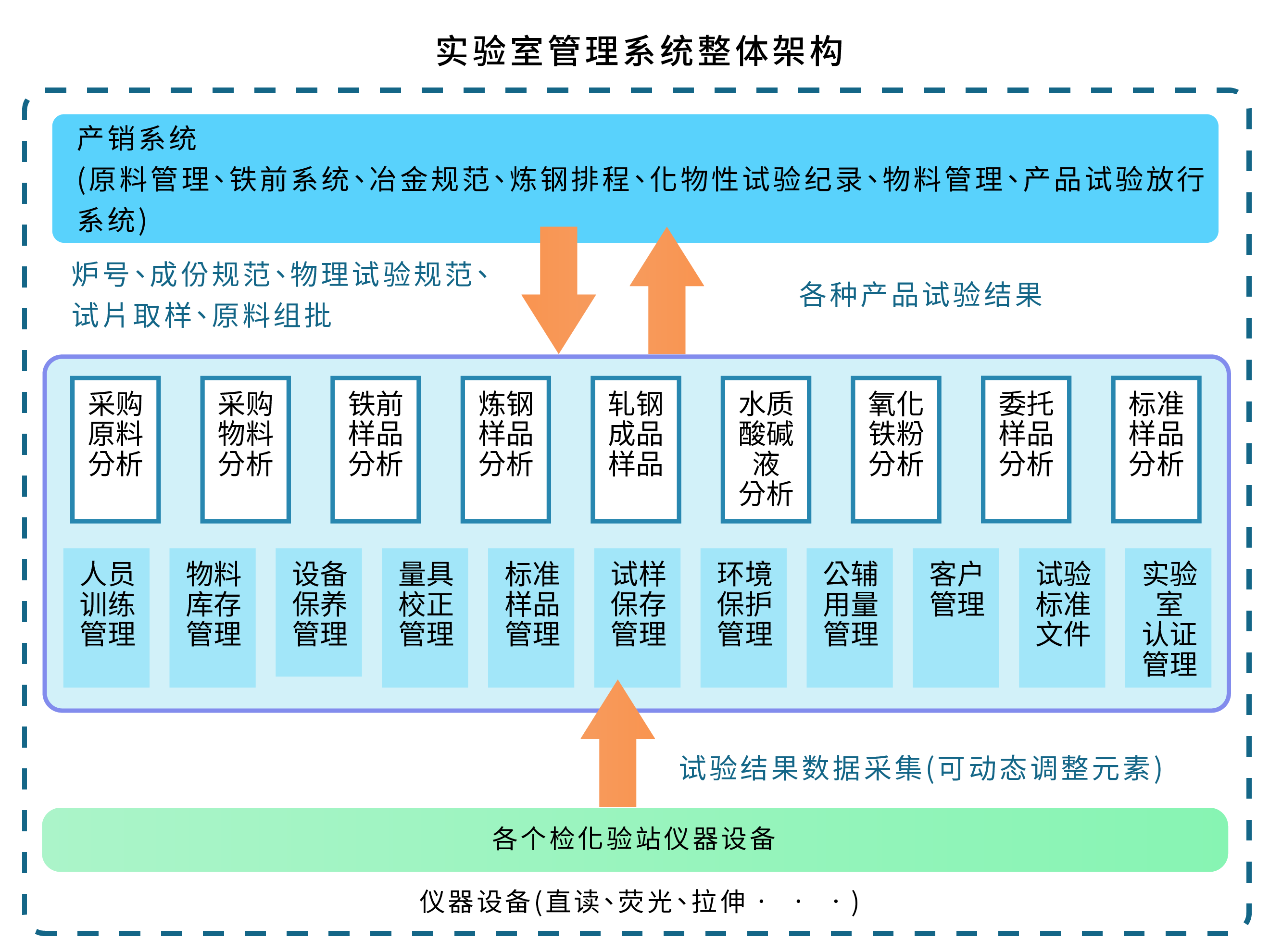
System Description
In order to achieve the purpose of informationization and automation of laboratory management, the process of collecting, computing, storing and transmitting the test result data generated by the test equipment can effectively improve the laboratories' work efficiency and reduce losses caused by quality abnormalities.
System Purpose
Chemical test management: Each process of steel smelting is related to the composition of chemical elements and changes in chemical composition. In order to accurately control the changes in chemical composition of materials before and after the process, samples will be taken and sent to the laboratory for analysis at any time. The laboratory must wait for the on-site factory to deliver samples around the clock (24 hours) to conduct test and analysis operations. The results of test and analysis must be returned to the site in the shortest time, so that each smelting factory can quickly adjust the process conditions and chemical composition changes to meet the company's production specifications and customer order release specifications, and can successfully produce steel embryos and continue to be produced in the downstream rolling mill.
Physical (mechanical) test management: After the steel rolling is produced, the test piece is taken from the steel product, and then the test piece is handed over to the physical laboratory. According to the order specifications of the production and sales system, various types of test piece processing are carried out. After testing the test equipment, the test results are collected, the report is printed and the production and sales system is returned. The specifications required for physical (mechanical) testing must be seamlessly integrated with the production and sales system to ensure that the steel produced can be tested according to customer requirements and can meet order requirements.
General business management: In addition to chemical test management and physical (mechanical) test management, a comprehensive laboratory management system is established in accordance with the business needs of the laboratory to achieve that all testing or management information complies with relevant quality standards and specifications, including: personnel training management, material (including drugs) inventory management, equipment maintenance management, measuring gauge calibration management, standard sample management, sample preservation management, environmental protection management, customer management, public auxiliary quantity management, test standard documents, laboratory certification management
System functions
Chemical test management: analysis of raw materials for procurement, iron pre-iron sample analysis (coking field, mixing field, sintering field, blast furnace, lime kiln and other factories), steelmaking sample analysis, fast division automation analysis, water quality/acid-alkali liquid analysis in cold rolling mills, iron oxide powder analysis, irregular chemical commissioned sample analysis, standard sample analysis
Physical (mechanical) test management: tests for finished steel rolling products (tensile test, bending test, impact test, hardness test, metallographic test, hammer tear test, Ai's test, non-metal inclusion test and other tests), irregular physical commissioned sample tests
General business management: personnel training management, material (including drugs) inventory management, equipment maintenance management, measuring gauge calibration management, standard sample management, sample preservation management, environmental protection management, customer management, public auxiliary quantity management, test standard documents, laboratory certification management
System Features
Connect the test specification data of the test piece sampled in the production and sales system, integrate the test specification information, and automatically group different test types (tension, impact, hardness,??) according to the test specification data.
The chemical composition analysis results can dynamically increase and decrease the number of elements and elastically adjust the arrangement order of elements from the receiving instrument, screen display, and finally the message format sent to the secondary system. There is no need to modify the program.
It can be dynamically set according to the sample category (or sampling location) and can be transmitted to multiple secondary systems (upper and downstream stations of the sampling location) and combined with different transmission message formats.
The test progress of irregular entrustment and procurement of raw materials can be traced
Multiple encryption can be performed on the analysis of purchased raw materials
The analysis time of the fast-segment sample can be used to count the quantity of the exceeding standard
The number of tests can be counted every day, weekly and monthly, and the number of samples analyzed in the sampling station can be further counted.
Planning suitable sample coding principles according to the sampling location
Provide automatic reminder maintenance function according to the fixed maintenance cycle of the instrument
Control the complete test progress status information of the test piece inside the laboratory (to be received, received, processed, tested, transmitted)
The system dispatches tasks according to the default experimental task rules and can be manually adjusted.
The system can automatically collect the test results of the test equipment
If the test equipment has an automated data reception interface, the system can send test instructions to the test equipment.
benefit
Improve laboratory work efficiency
Quickly respond to the test results
Quickly grasp the test progress
Establish a knowledge base in inheritance
System architecture diagram
Overall architecture of laboratory management system

Overall architecture of fast steelmaking automation analysis
